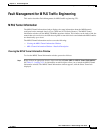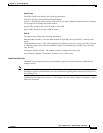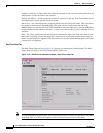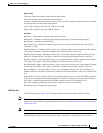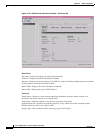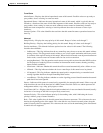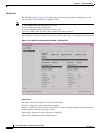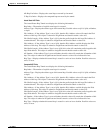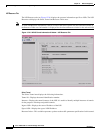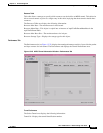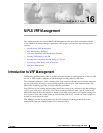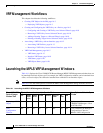
15-41
Cisco 12000/10700 v3.1.1 Router Manager User Guide
OL-4455-01
Chapter 15 MPLS Management
Fault Management for MPLS Traffic Engineering
Tunnel Status
Admin Status—Displays the desired operational status of this tunnel. Possible values are up ready to
pass packets, down, or testing in some test mode.
Operational Status—Indicates the actual operational status of this tunnel, which is typically but not
limited to, a function of the state of individual segments of this tunnel. Possible values are: up ready to
pass packets, down, testing in some test mode, unknown status cannot be determined, dormant,
notPresent some component is missing or lowerLayerDown down due to the state of lower layer
interfaces.
Instance Uptime—This value identifies the total time that this tunnel instances operational status has
been Up.
Advanced
Setup Priority—Displays the setup priority of this tunnel. Range of values are 0 through 7.
Holding Priority—Displays the holding priority for this tunnel. Range of values are 0 through 7.
Session Attributes—This bitmask indicates optional session values for this tunnel. The following
describes these bitfields:
• fastReroute—This flag indicates that the any tunnel hop may choose to reroute this tunnel without
tearing it down. This flag permits transit routers to use a local repair mechanism which may result
in violation of the explicit routing of this tunnel. When a fault is detected on an adjacent downstream
link or node, a transit router can reroute traffic for fast service restoration.
• mergingPermitted—This flag permits transit routers to merge this session with other RSVP sessions
for the purpose of reducing resource overhead on downstream transit routers, thereby providing
better network scalability.
• isPersistent—Indicates whether this tunnel should be restored automatically after a failure occurs.
• isPinned—This flag indicates whether the loose- routed hops of this tunnel are to be pinned.
• isComputed—This flag indicates whether the tunnel path is computed using a constraint-based
routing algorithm based on the mplsTunnelHopTable entries.
• recordRoute—This flag indicates whether or not the signaling protocol should remember the tunnel
path after it has been signaled.
Owner—Indicates which protocol created and is responsible for managing this tunnel. Values rsvp and
crldp should not be used at the head-end of a MPLS tunnel. Possible values are: admin represents all
management entities, rsvp, crldp, policyAgent, or other.
Local Protect In Use—Displays that the local repair mechanism is in use to maintain this tunnel (usually
in the face of an outage of the link it was previously routed over).
Instance Priority—This value indicates priority (in descending order, with 0 indicating the lowest
priority) within a group of tunnel instances.
Role—This value signifies the role that this tunnel entry/instance represents. This value must be set to
head at the originating point of the tunnel. This value must be set to transit at transit points along the
tunnel, if transit points are supported. This value must be set to tail at the terminating point of the tunnel
if tunnel tails are supported.



